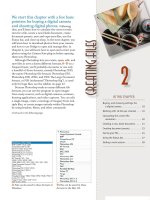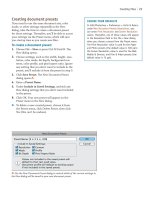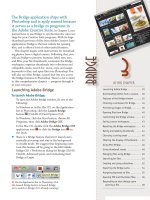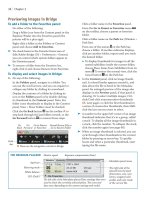Sử dụng photoshop cs5 part 27 doc
Bạn đang xem bản rút gọn của tài liệu. Xem và tải ngay bản đầy đủ của tài liệu tại đây (558.77 KB, 6 trang )
ptg
Selections & Masks 169
Editing layer masks
In these instructions, you’ll edit a layer mask by
applying strokes with the Brush tool. In the instruc-
tions on the next two pages, you’ll edit a mask by
using controls on the Masks panel. ese are very
important skills to learn.
To reshape a layer mask:
1. Choose the Brush tool (B or Shift-B).
2. On the Options bar, click a brush on the Brush
Preset picker, choose Mode: Normal, and choose
an Opacity of 100% to hide layer pixels fully or a
lower opacity to hide them partially.
3. Do either of the following:
To display the mask as a colored overlay on top of
the image, Alt-Shift-click/Option-Shift-click the
layer mask thumbnail on the Layers panel.
A–B
To display the mask in black and white with the
image hidden, Alt-click/Option-click the layer
mask thumbnail on the Layers panel.
4. Do either or both of the following:
Paint with white as the Foreground color to
reduce the mask and reveal pixels on the layer.
C
Paint with black as the Foreground color to
enlarge the mask and hide pixels on the layer.
D
➤ You can change brush settings, such as the size
or hardness, between strokes. Right-click in
the image to display a temporary brush preset
picker.
5. When you’re done editing the layer mask, click
the layer thumbnail to restore the normal display.
If it’s hard to see the overlay because it’s too similar
to the image color, you can change the overlay color
or opacity.
To choose layer mask display options:
1. Double-click a layer mask thumbnail on the Layers
panel (or click the mask thumbnail, then choose
Mask Options from the Masks panel menu).
2.
In the Layer Mask Display Options dialog, do
either or both of the following:
E
Click the Color square, choose a dierent overlay
color from the Color Picker, then click OK.
Change the Opacity percentage.
3.
Click OK.
4.
To view the change in the document, Alt-Shift-
click/Option-Shift-click the layer mask thumbnail.
C
Only the mask is displayed
in the document window.
We’re eliminating areas from
it by painting with white.
D
We’re enlarging the mask
by painting with black chosen
as the Foreground color.
B
e m a s k i s r e s h a p e d .
A
We’re painting out (remov-
ing) areas of the mask, which
is displayed as a red overlay
on top of the image.
E
By using the Layer Mask Display Options
dialog, you can change the Color and/or Opacity
of the mask overlay.
ptg
170 Chapter 9
e Density control on the Masks panel aects the
opacity of the overall mask, whereas the Feather
control aects the opacity of its edge. Both of these
useful controls are nondestructive, meaning they
don’t alter the original mask and can be readjusted
at any time.
To adjust the density or feather value of a
layer mask:
1. Click a layer that contains a layer mask, and
display the Masks panel.
A
2. Click the Select Pixel Mask button, then do
either or both of the following:
Reduce the Density value to lighten the black
part of the mask and partially reveal layer
pixels.
B–C
e lower the density, the more
transparent the mask.
Increase the Feather value to soften the edge of
the mask, for a more gradual transition between
the masked and unmasked areas (
A
, next page).
To refine the edges of a layer mask:
1. Click a layer that contains a layer mask, and dis-
play the Masks panel. Zoom to around 100%.
2.
Click Mask Edge; the Rene Mask dialog opens.
3.
Use the Rene Mask controls to adjust the soft-
ness or sharpness of the edge of the mask, as you
would for a selection in the Rene Edge dialog
(see page 161). We’ve found the following set-
tings to be helpful for cleaning up the edge of a
mask: a low Radius value (1–2), a low Contrast
value (5–7), and a slightly negative Contract/
Expand value to shrink the mask inward (to hide
more background pixels).
➤ We recommend keeping the Feather slider in the
Rene Mask dialog at 0 because it’s destructive,
and using the nondestructive Feather slider on
the Masks panel instead.
To swap the black and white areas in a
layer mask:
Do either of the following:
Click a layer that contains a layer mask, display
the Masks panel, then click the Invert button.
Click a layer mask thumbnail on the Layers
panel, then press Ctrl-I/Cmd-I.
➤ Repeat either method above to restore the
original state of the mask.
B
A mask is hiding all but the two owers on an image layer,
which is stacked above a solid white Background.
C
We reduced the Density of the mask to 77%, to allow it to
partially reveal the surrounding layer pixels.
A
By looking at the upper left area of the Masks
panel, we know that a Pixel Mask is selected.
ptg
Selections & Masks 171
USING THE MASKS PANEL TO DRAW ATTENTION TO PART OF AN IMAGE
B
e o r i g i n a l h a r d - e d g e d m a s k i s h i d i n g e v e r y t h i n g b u t t h e c a r o n a n
image layer, which is stacked above a solid white Background.
C
We reduced the Density value and increased
the Feather value for the layer mask to make
the transition between the masked and
unmasked areas more gradual. e car is still
the star of the show, but the soft imagery
around it provides a complementary setting.
A
We increased the Feather value of the mask to 96 px, to
make the transition between the masked and unmasked areas
more gradual.
ptg
172 Chapter 9
Working with layer masks
By default, a layer and its layer mask are linked
and, when moved, travel as a unit. If you want to
move either component separately, you have to
unlink them rst.
To move the layer content or mask
independently:
1. On the Layers panel, click the Link icon
between the layer and layer mask thumb-
nails.
A–B
e icon disappears.
2. Click either the layer thumbnail or the layer
mask thumbnail, depending on which one you
want to move.
3. Choose the Move tool (or hold down V to
spring-load the tool), then drag in the docu-
ment window.
C
4. Click between the layer and layer mask
thumbnails to make the link icon reappear.
To duplicate a layer mask or move it to
another layer:
Do either of the following:
To move a mask, drag its thumbnail to another
layer (you can’t move it to the Background).
To duplicate a mask, Alt-drag/Option-drag its
thumbnail to another layer.
When you load a mask as a selection, it displays in
the document as a marquee of “marching ants.”
To load a mask as a selection:
1. Do either of the following:
On the Layers panel, Ctrl-click/Cmd-click a
layer mask thumbnail.
On the Layers panel, click a layer mask thumb-
nail, then on the Masks panel, click the Load
Selection from Mask button.
A
A layer mask is hiding the center
of the tile layer and revealing part of
the underlying Background image.
C
With the Move tool, we dragged
the mask in the document window
to reveal a dierent part of the
Background. (If you want to move
the layer imagery instead, click the
layer thumbnail before dragging.)
B
We clicked the Link icon to disengage
the layer image from the mask, and also
clicked the layer mask thumbnail.
ptg
Selections & Masks 173
To deactivate a layer mask temporarily:
Do either of the following:
On the Layers panel, Shift-click the layer mask
thumbnail
A
(the thumbnail won’t become
selected).
On the Layers panel, click a layer mask thumb-
nail, then at the bottom of the Masks panel, click
the Disable/Enable Mask button.
B
A red X appears over the thumbnail on both the
Layers and Masks panels, and the entire layer is
now visible. To reactivate the mask at any time,
repeat either method above.
One disadvantage of using layer masks is that they
occupy some storage space (albeit a small amount),
so when you’re done using them, consider apply-
ing those whose eects you’re pleased with to make
them permanent and deleting those you don’t need.
When you apply or delete a mask, its thumbnail
disappears from the Layers panel.
Note: Before applying or deleting any masks — a
permanent change — use the File > Save As com-
mand to copy the le, and preserve the original le
that contains the layer masks for future editing.
To apply or delete a layer mask:
Do either of the following:
On the Layers panel, click a layer mask thumb-
nail, then on the Masks panel, click the Apply
Mask button to apply the mask or the Delete
Mask button to delete it.
On the Layers panel, right-click a layer mask
thumbnail and choose Apply Layer Mask or
Delete Layer Mask.
A
To deactivate or activate a layer mask via the
Layers panel, Shift-click the layer mask thumbnail.
A red X appears in the thumbnail.
B
To deactivate or activate a layer mask via the
Masks panel, click the layer mask thumbnail on
the Layers panel, then click the Disable/Enable
Mask button on the Masks panel.
SOME MASK TOPICS IN OTHER CHAPTERS
➤ “Editing the adjustment layer mask” on page 202
➤ “Fading the edge of a layer via a gradient in a
layer mask” on pages 244–246
➤ “Working with the Smart Filter mask” on page 322
➤ “To use type shapes as a layer mask” on page 349
ptg
174 Chapter 9
Comparing the selection methods
Now that you’re acquainted with most of the selection methods in Photoshop, you can use the following
summary to shop and compare.
SELECTION METHOD WHAT IT’S BEST FOR SELECTING
Rectangular and Elliptical
Marquee tools
Rectangular and round shapes; you can specify a width-to-height ratio or
dimensions (page 148)
Lasso tool Irregular areas; very useful for cleaning up selections created with other
tools or commands (page 149)
Polygonal Lasso tool Straight-edged shapes (page 149)
Quick Mask mode Paint a mask onto a document in Quick Mask mode (and remove areas of
the mask where necessary); it converts to a selection automatically when
the document is returned to Standard mode (pages 166–167)
Magnetic Lasso tool Objects or fi gures that are clearly delineated from their background in
tonality or color (see Photoshop Help)
Quick Selection tool Well-defi ned shapes, including irregular areas; creates selections by
detecting color boundaries (pages 152–153)
Magic Wand tool Color areas based on a Tolerance range; good for selecting a back-
ground area, such as sky or water; use the Lasso or Quick Selection tool
afterward to add areas or remove stray areas from the selection (pages
154–155)
Color Range command Discrete color areas; via a dialog, lets you select all occurrences of one
color or a specifi c tonal range (pages 156–157)
MODIFY SELECTIONS HOW IT WORKS
Add or subtract with a
selection tool
Shift to add; Alt/Option to remove; Alt-Shift/Option-Shift to select the
intersection of the existing and new selections
Refi ne Edge command Refi ne the smoothness, sharpness, or precision of a selection edge;
preview the selection on different backgrounds (pages 161–165)
Grow and Similar
commands
Enlarge a selection based on the current Tolerance setting of the Magic
Wand tool; the Similar command selects noncontiguous, similar areas
Convert a selection to a
path
Convert a selection to a path, reshape it by manipulating its anchor
points, then convert it back to a selection; or to create a smooth, precise
path, trace a shape with the Pen tool, then convert it to a selection
PRESERVE SELECTIONS METHOD
Save a selection as a
layer mask; refi ne the
mask; load the mask as
a selection
Save a selection as a layer mask (page 168); refi ne a selection before
saving it as a layer mask via the New Layer with Layer Mask option in the
Refi ne Edge dialog (page 161); change the mask density or feather value
using the Masks panel (page 170); refi ne the mask edges using the Refi ne
Mask dialog (page 170); load a layer mask as a selection (page 172)
Save a selection as an
alpha channel
Save a selection as an alpha channel to the Channels panel (page 160)









